
glenstone museum’s worldwide digital film premiere
Celebrating the completion of its newest building by Thomas Phifer and Partners, Glenstone Museum premieres its short film titled ‘You Are The Subject: Richard Serra at Glenstone.’ The film follows the installation of Richard Serra‘s sculpture ‘Four Rounds: Equal Weight, Unequal Measure’, 2017 in the new Pavilion which had been created specifically to house the colossal work. While the film showed last month at Montreal’s international film festival Le FiFA 2023, it is now being unveiled by producers Glenstone Museum and Rava Films with designboom in a worldwide digital premiere.
In time for the film’s premiere, designboom spoke with Thomas Phifer about his collaboration with Richard Serra and how the architecture was informed by the sculpture inside.
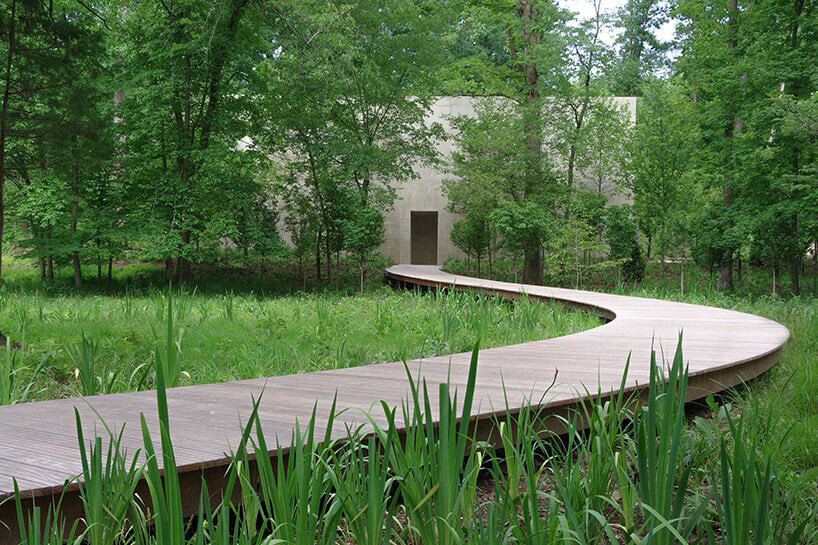 approaching the new building by Thomas Phifer and Partners | images courtesy Glenstone Museum
approaching the new building by Thomas Phifer and Partners | images courtesy Glenstone Museum
serra and phifer’s collaboration at glenstone
Joining the larger collection of Pavilions at the Glenstone Museum, completed by Thomas Phifer and Partners in August 2018, this new building was completed in June 2022; the result of a collaborative effort between architect and artist. While it functions as a vessel for the sculpture, ‘Four Rounds: Equal Weight, Unequal Measure,’ the structure is itself a continuation of the artwork inside. It is removed from the rest of the museum, quietly hidden amidst the wooded landscape in Potomac, Maryland. As visitors approach along a meandering footpath, the concrete building gradually unfolds from behind the trees, the monolithic artwork soon to be discovered within.
‘Four Rounds: Equal Weight, Unequal Measure’ takes shape as a single work composed of four cylindrical forms forged from solid steel. Although ranging in height, diameter and volume, each form weighs precisely 82 tons — the heaviest form that a foundry is able to forge. The surface of each form carries a rich, textured patina imprinted by the intense pressure of the forging process. The sculpture was created in 2017 while the Pavilions at the Glenstone Museum were nearing completion, and just before Thomas Phifer and Partners began work on this newest building.
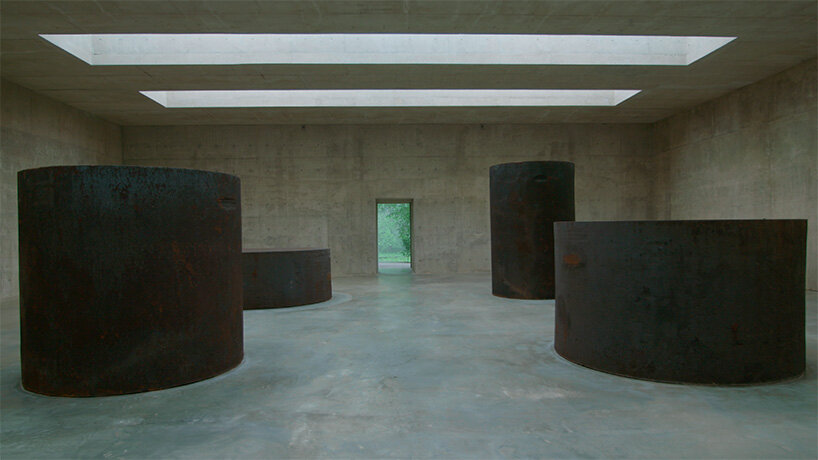 ‘Four Rounds: Equal Weight, Unequal Measure’ 2017 by Richard Serra installed at Glenstone Museum
‘Four Rounds: Equal Weight, Unequal Measure’ 2017 by Richard Serra installed at Glenstone Museum
washed in natural light
‘Four Rounds: Equal Weight, Unequal Measure’ 2017 now stands as the third artwork by Richard Serra at the Glenstone Museum. ‘Sylvester,’ 2001 and ‘Contour 290,’ 2004 occupy the grounds surrounding the Pavilions, and are backdropped by the rolling landscape. These two sculptures are showcased as part of the film ‘You Are The Subject: Richard Serra at Glenstone’ to demonstrate the contrast between Serra’s works outdoors and indoors.
One key correlation between these three artworks is that they are each displayed under natural sunlight. Designing the new building, Thomas Phifer and Partners had carried out a careful series of lighting studies to ensure the four rounds were washed uniformly with ambient sunlight. Ultimately the team landed on an array of four elongated skylights which cut deep into the thick structure and are enclosed with white glass. Thus, the texture of the oxidized steel surfaces are spotlighted together with their backdrop of raw concrete.
Follow the building’s design and construction along with the sculpture’s installation in this newly premiered film, together with designboom’s interview with architect Thomas Phifer below.
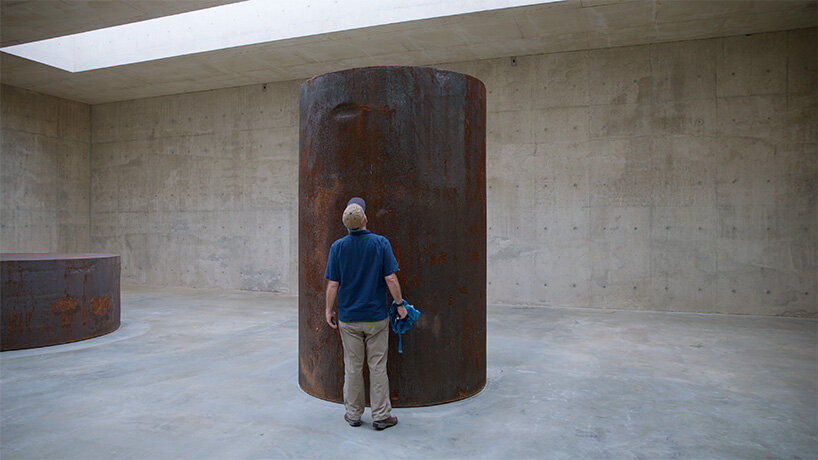 each of the four rounds weighs eighty-two tons
each of the four rounds weighs eighty-two tons
designboom (DB): When designing a museum or gallery, it can be difficult to strike a balance between how much the art itself should shine, and how much the architecture around it should shine. This project is unique because the building is an extension of the sculpture. Can you elaborate on this concept?
TP: I think that room in the woods is like the rooms in the pavilions. Because it brings this frame to particular, mostly singular works. It brings a frame to the artist. Rather than them being big, open, flexible spaces, they’re in very particular spaces that are worked on in concert with the artist. This pavilion is sitting out in the woods — and Richard Serra’s work is akin to rooms in the pavilion. With light, proportion, and space, it frames those works and causes that to be the lens through which you see those works.
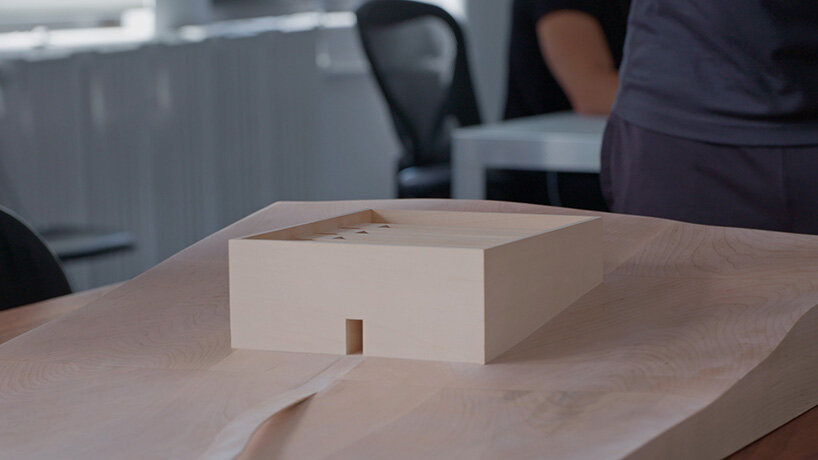 physical model by Thomas Phifer and Partners
physical model by Thomas Phifer and Partners
It’s just like in the pavilions. Every one of them has this way of providing a threshold, and a preparation to see the work. Some of those rooms in the pavilions have very thick walls. You go from one of the pavilions out back, and you look at the pool. And you then come from the pool, and you move to another room. Then you go through a thick wall, and you go from light, to shade, to shadow. Then back into the light. Here, you walk through the woods and the wetlands. Then you walk through this really small opening to enter into this room, and it’s completely filled with daylight. So there are are so many similarities between this pavilion and the others.
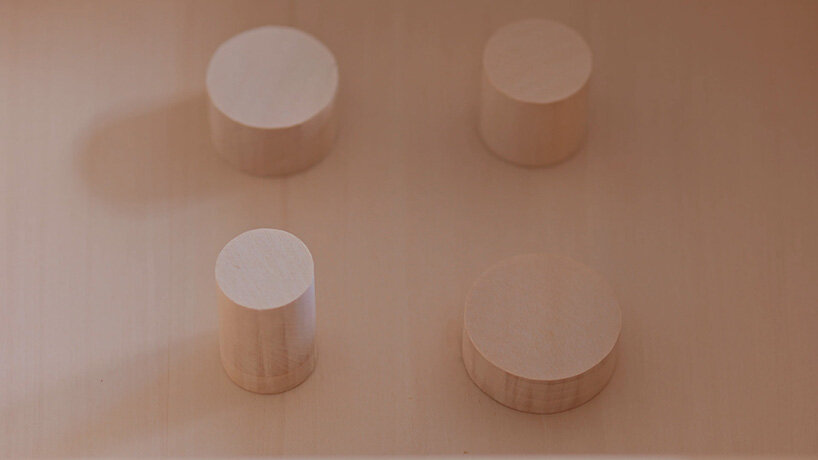 physical model of the sculpture
physical model of the sculpture
DB: Approaching the pavilion through the woods, the experience unfolds gradually.
TP: You have time to prepare yourself! These artworks are really amazing — and pretty powerful. So to have this kind of preparation where you walk through nature, the worries of the day drop away, and you’re walking through the woods and over the wetlands on the boardwalk and then all of a sudden you come through the small door, pretty thick wall — and you’re in.
DB: In the film it’s said that Richard Serra considers this sculpture as one piece: its four elements, the space around them, and the space in-between them.’ One could say that your pavilions can be experienced in this way as well. Is this by chance, or was this intentional?
TP: I had certainly never designed a museum with nine or ten spaces in perpetuity, with one particular artist. Clearly, when you walk into Richard Serra’s room, you see that work that he’s made is not separated from the space itself. It’s hard to disconnect the two. Whereas if you walk into MoMA and you see a room with ten or twelve pictures on the wall, you don’t think of those works all coming together and the room being a part of it. But when it’s just one artist, you do get the sense that those four rounds belong to that room.

